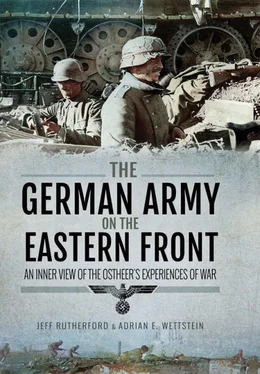Supply through the air was used in German offensive operations in 1941/42 only to a small degree. In addition to supplying armoured spearheads that pushed beyond their lines of communications, it was mostly used to transport personnel and equipment of the Luftwaffe itself. But when the tide turned and the Red Army went on the offensive in winter 1941, supplying encircled German strongholds became a major issue. Holding several key strongpoints, especially in the areas of Army Group North and Centre, such as Demiansk, Staraia Russa, Kholm or Suchinitischi, broke the back of Soviet offensive efforts, denying it essential lines of communication to supply the advancing forces. And supplying those encircled positions was only possible by air transport. What worked under severe strain in the winter of 1941/42 became somewhat of a defensive strategy with dire consequences for German troops in upcoming years. 1942 saw the most well-known German airlift, the one for the encircled Sixth Army in Stalingrad. Less well-known is the airlift for Velikye Luki in the central theatre of the Eastern front. [23]A Soviet offensive, attempting a breakthrough in the direction of the Baltic, started a few days after the Soviet counterattack at Stalingrad. The Red Army achieved an encirclement of the strategically important city of Velikye Luki after a few days and tried to push further westward, but was stopped by arriving German reinforcements and its own supply problems, due in large part to the bypassed German-controlled Velikye Luki sitting astride numerous communication and supply lines. The German counter-thrust only reached the western outskirts of the city and freed a small group of the beleaguered garrison, but it failed to retake the city. Considering the size of the Soviet and German forces in combat and the overall situation on the Eastern front, Velikye Luki was a German defensive victory, but a bloody one. The foundation of this victory was the nearly two-month stand of the almost 7,000-man garrison of Velikye Luki, which was only possible due to air supply. An idea of the problems and the size of the airlift can be seen in the final report of the commanding Luftwaffenkommando Ost (Air Force Command East, the overall command of air force units operating in the area of Army Group Centre in 1942): [24]
6. Deployment of flying units
During the fighting for Velikiye Luki, the flying units of Luftwaffenkommando Ost [25]faced the difficult task of supporting the ground forces in the defence and later in the attack. In addition to this task, the supply of the encircled garrison still took place, which, as a result of the development of the situation, increasingly forced the mass of the combat forces to be used for the supply mission. […]
E) Air supply
aa) Supply by bomber formations
Since the encircled parts of Velikiye Luki urgently needed supplies, a large part of the bomber formations were used to drop weapons and ammunition, medical supplies and rations. In every possible type of weather, by day and night, supply containers were dropped over the city, [and] later on the citadel and eastern railway station. All the crews who were deployed to drop supply goods achieved unparalleled performances through their missions, despite low-altitude flights often carried out against the heaviest defence. Heavy losses occurred during the attempts to drop supplies to the garrisons of the citadel and the eastern railway station, which were compressed into a narrow space. All possibilities (air drops using the lower cloud cover until the approach run, approaches by low level flight with a steep climb shortly to the air drop altitude before the target, twilight and night drops, targeted air drops of supply containers [food, medicine, infantry ammunition] without parachute) were exhausted. In doing so, it turned out that the dropping of supply containers on small-area targets like the citadel (250m x 120m) represents a task which cannot be solved by horizontal dropping. With the approach of the supply aircraft, the enemy, who had worked all the way up close to the ramparts of the citadel, fired a blocking barrage over the airspace of the citadel with infantry and anti-aircraft weapons of all calibres, which was broken through by the He 111 at air drop altitudes of 80-200m to carry out their missions.
bb) Supply by Stuka
In addition to the bomber formations, Stuka formations were also deployed for air drops for the first time. This use became necessary due to the strong defence and the small drop targets. During the dive, ‘supply bombs,’ were dropped, with and without parachutes, into the smallest areas – i. e. into single ‘hedgehogs’. All the supply bombs dropped without a parachute hit the target area, but they were partly broken by the hard impact and often could not be found due to the absence of smoke signals. The supply containers dropped with parachutes drifted for the most part and fell into enemy hands.
cc) Supply by cargo-carrying gliders
The use of the tow-planes to Velikiye Luki resulted in excellent successes despite the strong enemy defence and bad weather situation. For the use of gliders it was necessary to land a glider guide in Velikiye Luki, who was able to check the suitability of the landing field and to take all necessary measures for the landing of the cargo-carrying gliders. A daylight mission of cargo-carrying gliders with tow-planes up over the target could only promise little success with the strong defences appearing around Velikiye Luki. In spite of this, 4 missions were successfully carried out during the day.
With missions at dawn and dusk the disadvantages of the night take-off or, to be more precise, night landing had to be accepted, since the advantages of the unseen approach offered a greater guarantee for the successful execution of the orders. Eight Go 242s [26]were dragged to the target in night missions and landed there with the help of paths of positioned flare and flare signals.
In an action that recklessly disregarded [the enemy defence], the garrison of Velikiye Luki was supplied by the landing of 17 cargo-carrying gliders with ATGs with crews, assault groups, machine gun ammunition, flamethrowers, rations, medical equipment and mail. Due to the lack of any news of their fate, it must be concluded that two cargo-carrying gliders landed in enemy territory.
The landing on the County Fair Street in Velikiye Luki, and later on the area of the Eastern railway station demanded great skill and quick decisiveness. Due to the inadequate landing possibilities in such a confined space, a partial destruction of the supply equipment which had already been brought into the target area by crash landings could not be prevented.
In heroic, voluntary efforts, the glider pilots have brought material and moral support to the units fighting on the ground for further stubborn defence.
The long endurance of the garrison of Velikiye Luki under the toughest conditions of combat and weather was made possible only by the air supply of the combat transport and gliders formations, which was carried out with the greatest grit and highest commitment. Without their commitment, the defensive power of the encircled units would have soon come to a standstill as a result of the loss of weapons and a lack of ammunition. […]
G) Numerical overview of missions, successes, losses
16) Missions and dropped bombs: In the period from 25.11.42-19.1.43, 298 reconnaissance aircraft, 1,393 bombers, 46 nuisance raiders, 403 Stuka , 1,554 fighter, 310 bombers and 94 Stuka with supply missions, [and] 25 gliders were deployed. A total of 4,163 aircraft. Dropped bombs: 1,450.1 tons.
17) Successes
[…]
291.27 tons supply goods, 12 mortars, 4.36 cbm of fuel dropped by aircraft
23.6 tons supply goods, 4 guns, 17 machine guns, 74 soldiers (gun crews and assault groups), 12 flame-throwers, 3 mortars transported by gliders
Читать дальше






![John Stieber - Against the Odds - Survival on the Russian Front 1944-1945 [2nd Edition]](/books/405234/john-stieber-against-the-odds-survival-on-the-russian-front-1944-1945-2nd-edition-thumb.webp)





